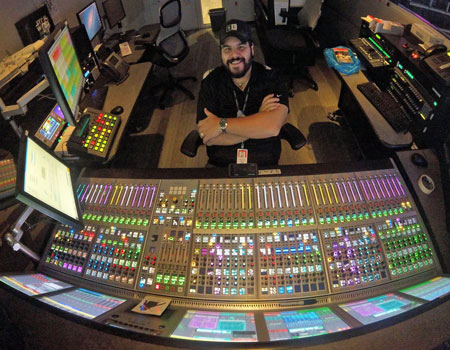Broadcast News
16/08/2019
Alex Martinez Discusses Career In Broadcast Audio Business

Sound Engineer Alex Martinez who works at Univision discusses his career in the broadcast audio business and what he thinks will be the biggest change to the way programs will be mixed over the next five years.
Tell us a little bit about who you are and what you do?
I'm the audio operator for Univision Noticias, the news wing of Univision Network, where I’ve had the privilege of working for roughly seven years. I mostly cover our live network news shows. This includes Primer Impacto, Noticiero Univision, Noticiero Univision en UniMás and Noticiero Univision Edicion Nocturna. I also work on the bigger special news events, such as US State of the Union speeches, US and Latin American election coverage and Papal visits around the globe, among many others.
How did you get into the broadcast audio business? What made you realize this was the career path you wanted to take?
I got into broadcast because of my love of audio, our fast-paced schedules and the content we cover. I love working under pressure. Whether a breaking news event across the world or a presidential election here in the States, my team always seems to really shine in these scenarios; and I’m happy to be a part of that. I also gravitated to broadcast because I wanted to mix for a larger audience. The growth potential at the network level to go from live concerts to in-studio and live broadcast is huge, you can’t get much larger than a network seen by so many in the US and simulcast to so many other countries around the world.
But my foray into audio dates back to high school, when I was working for a friend of mine who was a DJ at a local radio station. Back then, I made $50 a night, mostly lugging record crates in and out of appearances, and got to hang with them during the events. That was my first experience seeing the power that audio has over listeners’ emotions and their way of thinking. I was hooked. I wanted to learn how the recipe was put together. Soon after, I began an apprenticeship with a local club owner who, for the next decade, taught me signal flow, how to mix and even “why” circuitry behaves the way it does. Mixing live bands solidified my love for audio mixing and the technical prowess needed to do it properly. It was halfway through this apprenticeship that I decided to formally go for a second college degree, this time focused on audio.
What lead you to Univision?
It was serendipitous, really. I was working for Avid’s Pro Tools Certification School as a student advisor, and Univision called one day because they wanted to look into certifying their audio operators. However, they needed the instructor to be bilingual. The call came to me as I was the only on-site advisor who was bilingual. They invited me to their studios for a tour, and I fell in love with the fast pace and high energy on set. They just so happened to have been looking for a new audio operator, and I jumped at the opportunity.
How have you seen audio technologies, and the way sound is captured, mixed and delivered, evolve over your career? How has this changed programming or the way you work?
When I started in audio, we were still using tape- and reel-to-reel, so I think it's safe to say that audio technology has evolved tremendously. The progression from recording in analog to recording on digital and non-linear editing has been the biggest change I've seen. Everything is instantly available to mix and edit. We’re able to turn a recorded segment, edit it and send it to master within seconds. This has allowed us to now be able to update any relevant news within minutes and have it ready for the next airing on the next time zone.
On the delivery side, the current broadcast standard may no longer be accurate. The biggest change I've found is that now we’re mixing more for on-demand audiences who are tuning in on different platforms. I foresee our format changing in the next few years and adapting to this as a norm. Similar to the way in which music migrated from CD-quality to MP3 formats, so, too, will broadcast evolve in the same manner. Audio engineers will have to overcome the challenge of its viewers tuning in from home theater setups in 5.1 and mono firing speakers from a smart phone streaming live from a social media site. Automating certain tasks will also become more frequent.
What do you see as the biggest change to the way programs will be mixed in the next five years?
The biggest change is the immediacy of everything, and the quality it’s sent in. The amount of signal loss and compression that occurs when something is streamed is going to be a huge factor in the upcoming years. Everything newsworthy will be based off social media and how quickly we can come on-air to inform our audiences. I just hope we don’t lose the artform of mixing in the evolution to social media and automation. When you automate certain audio protocols, you lose that touch that makes our shows so engulfing and emotional. I can lead our audiences through the emotional highs and lows and transitions of our stories on-air and have them feel as though they watched one cohesive show – not just a bunch of random stories smashed together. This is only achieved with actual mixing within proper dynamic range.
What is the workflow that you follow?
For most shows, I sit with the director and go through the rundown he created with the rest of production. Based on the show’s needs, I’ll then go meet with our floor manager and tell him which mics and combos I need, and what the show will require for each individual segment. Everything is dictated based off how much movement we have: how many guests, translation requirements, etc. Then I work with the technical production manager to discuss the live satellite feeds. At that point, we patch the live feeds into one of our Calrec consoles and clean them up as needed so that they are broadcast-quality and level. Lastly, we establish communication with our internal studio and any necessary external sources and fold-back mixes. This would also include any mix minus needed for said show.
What Calrec consoles do you use? Are there any features that make your job easier, help you to produce a better-quality product, benefitted your workflow or increased your productivity?
Currently, I use the Calrec Artemis set up as 48-fader frame, but I actually started mixing broadcast audio on the Alpha. Univision also currently deploys the Apollo, but I prefer my beloved Artemis, and the Summa console for smaller productions.
The ease of patching and routing on the Calrec Artemis has been a game changer. The console allows me to do everything internally, and from the comfort of my mix position. It has completely eliminated the need to go to any type of patch bay, while the flexibility of internal routing saves me a lot of time. Whenever necessary, I can quickly route anything the director needs and adapt to any changes without worrying that I am sacrificing my attention to the mix.
Then, there's the most important part: the sound. As mixers, we sometimes forget how a clean signal can drastically ease our tasks. The console itself is the clearest console I’ve ever had the pleasure to work on. The noise floor is so low that it's imperceptible, thanks to the EQ and compressor. There’s no unwanted color or harmonics, it’s amazing how clean it sounds. It allows the elements to just sit in the mix and mingle with each other, instead of fighting for the audio space.
Can you think of a time when the Calrec consoles helped resolve any problems you were facing during a production?
There was a time during the 2016 US election that we had to use multiple studios, which required different control rooms. We had to unite them and work out of three studios simultaneously with continuous translation – from Spanish to English and English to Spanish – to air, throughout. At one point, I believe we had about 12 translators going simultaneously. Of course, this was in addition to our in-studio talent, guests and live feeds. The broadcast was aired live on our two networks and simulcast on social media. Due to the flexibility of the Calrec console, I was able to route all audio, mix minus and outputs (with different reference levels) without having to rely on other control rooms for additional I/O or submixing.
www.calrec.com
Tell us a little bit about who you are and what you do?
I'm the audio operator for Univision Noticias, the news wing of Univision Network, where I’ve had the privilege of working for roughly seven years. I mostly cover our live network news shows. This includes Primer Impacto, Noticiero Univision, Noticiero Univision en UniMás and Noticiero Univision Edicion Nocturna. I also work on the bigger special news events, such as US State of the Union speeches, US and Latin American election coverage and Papal visits around the globe, among many others.
How did you get into the broadcast audio business? What made you realize this was the career path you wanted to take?
I got into broadcast because of my love of audio, our fast-paced schedules and the content we cover. I love working under pressure. Whether a breaking news event across the world or a presidential election here in the States, my team always seems to really shine in these scenarios; and I’m happy to be a part of that. I also gravitated to broadcast because I wanted to mix for a larger audience. The growth potential at the network level to go from live concerts to in-studio and live broadcast is huge, you can’t get much larger than a network seen by so many in the US and simulcast to so many other countries around the world.
But my foray into audio dates back to high school, when I was working for a friend of mine who was a DJ at a local radio station. Back then, I made $50 a night, mostly lugging record crates in and out of appearances, and got to hang with them during the events. That was my first experience seeing the power that audio has over listeners’ emotions and their way of thinking. I was hooked. I wanted to learn how the recipe was put together. Soon after, I began an apprenticeship with a local club owner who, for the next decade, taught me signal flow, how to mix and even “why” circuitry behaves the way it does. Mixing live bands solidified my love for audio mixing and the technical prowess needed to do it properly. It was halfway through this apprenticeship that I decided to formally go for a second college degree, this time focused on audio.
What lead you to Univision?
It was serendipitous, really. I was working for Avid’s Pro Tools Certification School as a student advisor, and Univision called one day because they wanted to look into certifying their audio operators. However, they needed the instructor to be bilingual. The call came to me as I was the only on-site advisor who was bilingual. They invited me to their studios for a tour, and I fell in love with the fast pace and high energy on set. They just so happened to have been looking for a new audio operator, and I jumped at the opportunity.
How have you seen audio technologies, and the way sound is captured, mixed and delivered, evolve over your career? How has this changed programming or the way you work?
When I started in audio, we were still using tape- and reel-to-reel, so I think it's safe to say that audio technology has evolved tremendously. The progression from recording in analog to recording on digital and non-linear editing has been the biggest change I've seen. Everything is instantly available to mix and edit. We’re able to turn a recorded segment, edit it and send it to master within seconds. This has allowed us to now be able to update any relevant news within minutes and have it ready for the next airing on the next time zone.
On the delivery side, the current broadcast standard may no longer be accurate. The biggest change I've found is that now we’re mixing more for on-demand audiences who are tuning in on different platforms. I foresee our format changing in the next few years and adapting to this as a norm. Similar to the way in which music migrated from CD-quality to MP3 formats, so, too, will broadcast evolve in the same manner. Audio engineers will have to overcome the challenge of its viewers tuning in from home theater setups in 5.1 and mono firing speakers from a smart phone streaming live from a social media site. Automating certain tasks will also become more frequent.
What do you see as the biggest change to the way programs will be mixed in the next five years?
The biggest change is the immediacy of everything, and the quality it’s sent in. The amount of signal loss and compression that occurs when something is streamed is going to be a huge factor in the upcoming years. Everything newsworthy will be based off social media and how quickly we can come on-air to inform our audiences. I just hope we don’t lose the artform of mixing in the evolution to social media and automation. When you automate certain audio protocols, you lose that touch that makes our shows so engulfing and emotional. I can lead our audiences through the emotional highs and lows and transitions of our stories on-air and have them feel as though they watched one cohesive show – not just a bunch of random stories smashed together. This is only achieved with actual mixing within proper dynamic range.
What is the workflow that you follow?
For most shows, I sit with the director and go through the rundown he created with the rest of production. Based on the show’s needs, I’ll then go meet with our floor manager and tell him which mics and combos I need, and what the show will require for each individual segment. Everything is dictated based off how much movement we have: how many guests, translation requirements, etc. Then I work with the technical production manager to discuss the live satellite feeds. At that point, we patch the live feeds into one of our Calrec consoles and clean them up as needed so that they are broadcast-quality and level. Lastly, we establish communication with our internal studio and any necessary external sources and fold-back mixes. This would also include any mix minus needed for said show.
What Calrec consoles do you use? Are there any features that make your job easier, help you to produce a better-quality product, benefitted your workflow or increased your productivity?
Currently, I use the Calrec Artemis set up as 48-fader frame, but I actually started mixing broadcast audio on the Alpha. Univision also currently deploys the Apollo, but I prefer my beloved Artemis, and the Summa console for smaller productions.
The ease of patching and routing on the Calrec Artemis has been a game changer. The console allows me to do everything internally, and from the comfort of my mix position. It has completely eliminated the need to go to any type of patch bay, while the flexibility of internal routing saves me a lot of time. Whenever necessary, I can quickly route anything the director needs and adapt to any changes without worrying that I am sacrificing my attention to the mix.
Then, there's the most important part: the sound. As mixers, we sometimes forget how a clean signal can drastically ease our tasks. The console itself is the clearest console I’ve ever had the pleasure to work on. The noise floor is so low that it's imperceptible, thanks to the EQ and compressor. There’s no unwanted color or harmonics, it’s amazing how clean it sounds. It allows the elements to just sit in the mix and mingle with each other, instead of fighting for the audio space.
Can you think of a time when the Calrec consoles helped resolve any problems you were facing during a production?
There was a time during the 2016 US election that we had to use multiple studios, which required different control rooms. We had to unite them and work out of three studios simultaneously with continuous translation – from Spanish to English and English to Spanish – to air, throughout. At one point, I believe we had about 12 translators going simultaneously. Of course, this was in addition to our in-studio talent, guests and live feeds. The broadcast was aired live on our two networks and simulcast on social media. Due to the flexibility of the Calrec console, I was able to route all audio, mix minus and outputs (with different reference levels) without having to rely on other control rooms for additional I/O or submixing.
www.calrec.com
Top Related Stories
Click here for the latest broadcast news stories.
11/11/2016
What Is The Future For Immersive Audio?
Peter Poers, Managing Director at Jünger Audio, looks at production efforts versus consumer experience. Introduction Along with the evolution of highe
What Is The Future For Immersive Audio?
Peter Poers, Managing Director at Jünger Audio, looks at production efforts versus consumer experience. Introduction Along with the evolution of highe
09/08/2012
Blackmagic Design Announces Major New Software Update
Blackmagic Design has announced a major new software update that adds full-audio mixing capability to its ATEM 1 M/E Production Switcher and ATEM Tele
Blackmagic Design Announces Major New Software Update
Blackmagic Design has announced a major new software update that adds full-audio mixing capability to its ATEM 1 M/E Production Switcher and ATEM Tele
20/02/2024
NADiV Audio Introduces Range Of Dante Audio And Control Devices
NADiV Audio has launched its NADiV range of Dante-enabled audio interface and control devices for portable and installed AV and pro audio environments
NADiV Audio Introduces Range Of Dante Audio And Control Devices
NADiV Audio has launched its NADiV range of Dante-enabled audio interface and control devices for portable and installed AV and pro audio environments
28/07/2023
DHD audio Unveils XS3 Core Audio Processor
DHD audio has announced a new addition to its modular range of audio studio equipment and systems. The XS3 core audio processor supports up to 20 ster
DHD audio Unveils XS3 Core Audio Processor
DHD audio has announced a new addition to its modular range of audio studio equipment and systems. The XS3 core audio processor supports up to 20 ster
12/04/2023
Audio-Technica's BP3600 Immersive Audio Microphone Now Available
Audio-Technica has announced scheduled availability in Europe and the UK for its recently launched BP3600 Immersive Audio Microphone. A premium broadc
Audio-Technica's BP3600 Immersive Audio Microphone Now Available
Audio-Technica has announced scheduled availability in Europe and the UK for its recently launched BP3600 Immersive Audio Microphone. A premium broadc
31/03/2023
Digital Audio Denmark Introduces AX Center Thunder|Core Audio Interface
Digital Audio Denmark's new AX Center is a dedicated Thunderbolt modular audio interface with dual mic and instrument inputs, dual headphone and monit
Digital Audio Denmark Introduces AX Center Thunder|Core Audio Interface
Digital Audio Denmark's new AX Center is a dedicated Thunderbolt modular audio interface with dual mic and instrument inputs, dual headphone and monit
10/04/2002
Sonic introduces DVD-Audio Centre LE
Sonic Solutions have introduced the DVD-Audio Creator LE – a highly-affordable DVD-Audio authoring system with advanced features. Incorporating core t
Sonic introduces DVD-Audio Centre LE
Sonic Solutions have introduced the DVD-Audio Creator LE – a highly-affordable DVD-Audio authoring system with advanced features. Incorporating core t
05/06/2014
A Viable Economic Alternative to AD...
Both Spoken Subtitling and Audio Description may be candidate services that could benefit from the application of Text-To-Speech technology, says John
A Viable Economic Alternative to AD...
Both Spoken Subtitling and Audio Description may be candidate services that could benefit from the application of Text-To-Speech technology, says John
14/05/2012
Jünger Audio Makes Audio Loudness Its Focus At Broadcast Asia 2012
Dynamics specialist Jünger Audio will focus on controlling audio loudness in the broadcast chain at this year’s Broadcast Asia convention in Singapore
Jünger Audio Makes Audio Loudness Its Focus At Broadcast Asia 2012
Dynamics specialist Jünger Audio will focus on controlling audio loudness in the broadcast chain at this year’s Broadcast Asia convention in Singapore
08/06/2011
Jünger Audio Introduces New High Performance Audio Processing Products At Broadcast Asia 2011
Dynamics processing specialist Jünger Audio will be showing a number of new projects at Broadcast Asia 2011 (Stand: 4U3-01), including the award-winni
Jünger Audio Introduces New High Performance Audio Processing Products At Broadcast Asia 2011
Dynamics processing specialist Jünger Audio will be showing a number of new projects at Broadcast Asia 2011 (Stand: 4U3-01), including the award-winni
22/03/2017
Jünger Audio Demos Audio Processors At CABSAT 2017
Jünger Audio will be promoting its Smart Audio concept at this year's CABSAT exhibition in Dubai (Booth 102, Hall 1) by focusing attention on effectiv
Jünger Audio Demos Audio Processors At CABSAT 2017
Jünger Audio will be promoting its Smart Audio concept at this year's CABSAT exhibition in Dubai (Booth 102, Hall 1) by focusing attention on effectiv
23/02/2017
Jünger Audio To Demo Audio Processors
Jünger Audio will be promoting its Smart Audio concept at this year's CABSAT exhibition in Dubai by focusing attention on effective, high quality and
Jünger Audio To Demo Audio Processors
Jünger Audio will be promoting its Smart Audio concept at this year's CABSAT exhibition in Dubai by focusing attention on effective, high quality and
17/07/2023
ES-Pro Audio Appointed To Handle Prism Sound's Range Of Audio Converters
Prism Sound has appointed ES-Pro Audio to handle its entire range of audio converters to the professional market in Germany. Formerly a Prism Sound re
ES-Pro Audio Appointed To Handle Prism Sound's Range Of Audio Converters
Prism Sound has appointed ES-Pro Audio to handle its entire range of audio converters to the professional market in Germany. Formerly a Prism Sound re
22/05/2023
Synthax Audio Appointed Distributor For TIERRA Audio
Synthax Audio UK has been appointed UK and Ireland distributor for TIERRA Audio's range of professional audio products. Founded in 2018 in Madrid, Spa
Synthax Audio Appointed Distributor For TIERRA Audio
Synthax Audio UK has been appointed UK and Ireland distributor for TIERRA Audio's range of professional audio products. Founded in 2018 in Madrid, Spa
22/07/2015
Jünger Audio Prototype For IBC 2015
Jünger Audio will use IBC 2015 to showcase a prototype audio monitoring solution that will allow broadcasters to check the quality of all immersive au
Jünger Audio Prototype For IBC 2015
Jünger Audio will use IBC 2015 to showcase a prototype audio monitoring solution that will allow broadcasters to check the quality of all immersive au















